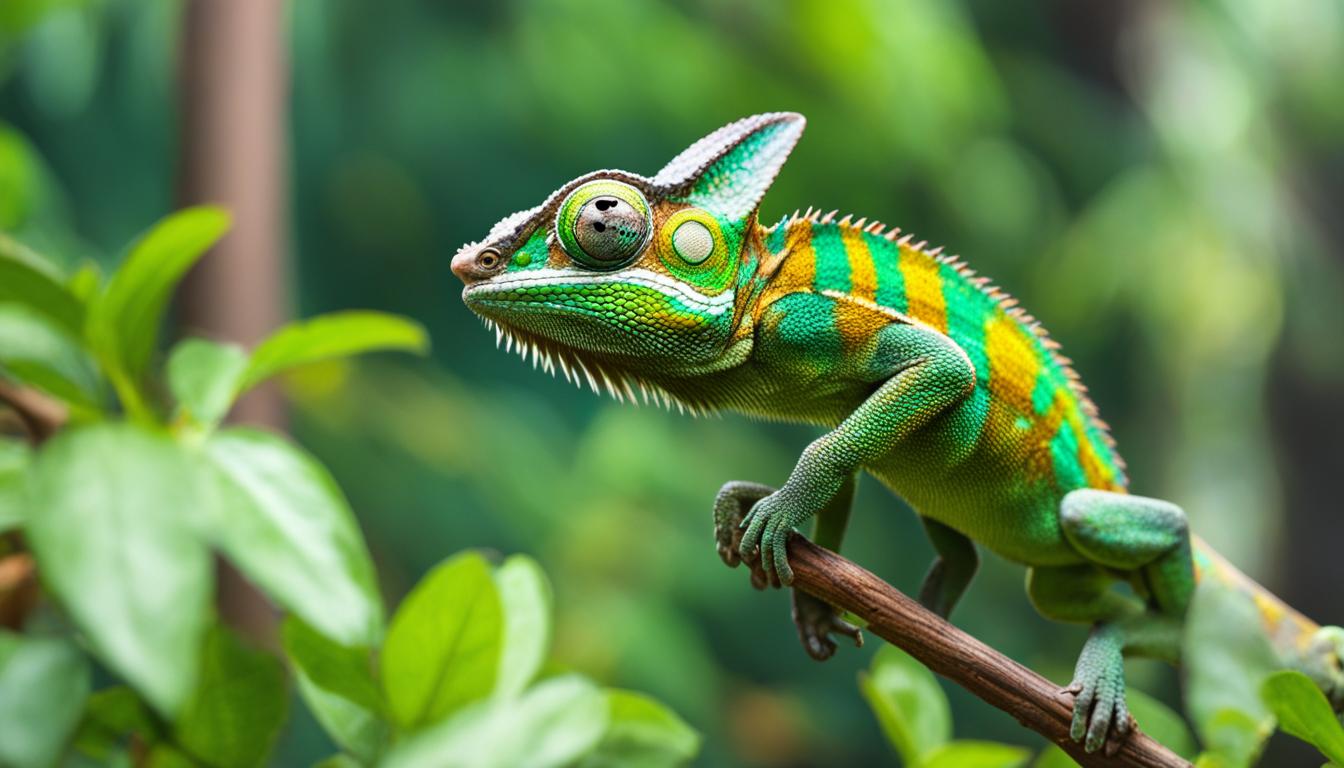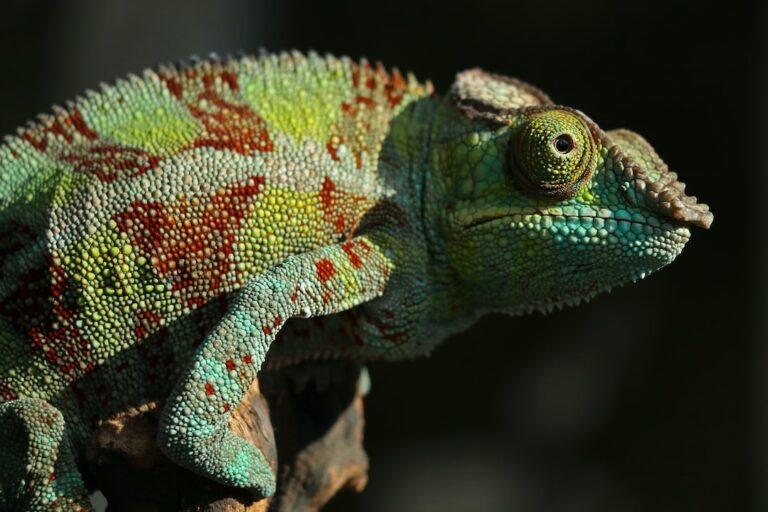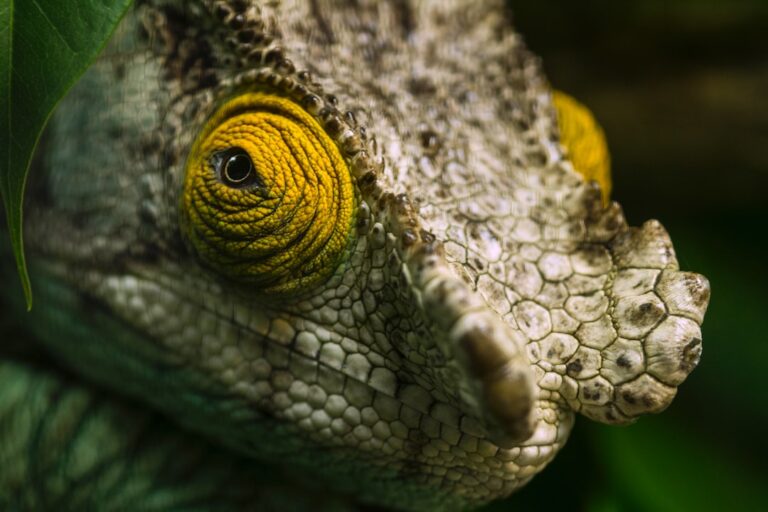Can Chameleons Jump?
Chameleons are a unique group of reptiles known for their ability to change color and their long, sticky tongues. They belong to the family Chamaeleonidae and are found in various parts of the world, including Africa, Madagascar, and parts of Asia and Europe. Chameleons are known for their distinctive appearance, with their bulging eyes, independently moving eyes, and prehensile tails.
One of the most fascinating abilities of chameleons is their ability to change color. This is not just for camouflage, but also for communication and thermoregulation. Chameleons have specialized cells in their skin called chromatophores, which contain pigments that can expand or contract to create different colors. They can change their color rapidly in response to their environment or their mood.
Another remarkable physical ability of chameleons is their long, sticky tongues. Their tongues can be longer than their body length and can be shot out at high speeds to catch prey. The tongue is covered in a sticky mucus that helps them capture insects and other small prey. This unique adaptation allows chameleons to be highly efficient hunters.
Table of Contents
Understanding the mechanics of jumping in reptiles
Jumping is a common form of locomotion in many animals, including reptiles. Reptiles use a combination of muscle power and body mechanics to propel themselves off the ground and into the air. The muscles involved in jumping include the leg muscles, which provide the power for the jump, and the tail muscles, which help with balance and stability.
Reptiles have a unique way of jumping compared to other animals. Instead of using their hind legs alone, like mammals do, reptiles use both their hind legs and their tails to generate power for the jump. This allows them to achieve greater height and distance in their jumps. The tail acts as a lever, providing additional force and propulsion.
The anatomy of a chameleon and its potential for jumping
Chameleons have a unique body structure that is well-suited for jumping. They have long, slender bodies with flexible spines, which allows them to bend and twist their bodies in various directions. This flexibility is essential for generating power and control during jumps.
One of the key features of a chameleon’s body that aids in jumping is its long tail. The tail acts as a counterbalance, helping the chameleon maintain stability and control during jumps. It also provides additional propulsion, allowing the chameleon to achieve greater height and distance in its jumps.
Chameleons also have powerful legs, which provide the necessary force for jumping. Their hind legs are longer and stronger than their front legs, allowing them to generate more power. The muscles in their legs are well-developed, enabling them to propel themselves off the ground with great force.
Examining the jumping behavior of chameleons in the wild
In the wild, chameleons use jumping as a means of moving through their environment. They are arboreal creatures, meaning they spend most of their time in trees and other elevated areas. Jumping allows them to navigate between branches and reach their desired locations.
Chameleons are known for their impressive jumping abilities. They can jump several times their body length in a single leap. This allows them to cover large distances quickly and efficiently. They use their long tails and powerful legs to launch themselves off a branch and propel themselves through the air.
The role of jumping in chameleon hunting and defense strategies
Jumping plays a crucial role in both hunting and defense strategies of chameleons. When it comes to hunting, chameleons use their jumping abilities to catch prey. They can spot an insect from a distance, calculate the trajectory, and then launch themselves towards it with precision. Their long tongues, combined with their jumping skills, make them highly effective hunters.
In terms of defense, chameleons use jumping as a means to escape predators. When threatened, they can quickly jump away from danger and find safety in the trees. Their ability to jump long distances allows them to outmaneuver predators and avoid capture.
Can chameleons jump over obstacles?
Chameleons have impressive jumping abilities, but whether they can jump over obstacles in their environment depends on the size and nature of the obstacle. Chameleons are primarily arboreal creatures, so their natural habitat consists of trees and branches. They are well-adapted to navigating through this type of environment.
However, if the obstacle is too large or if it is a flat surface without any grip, chameleons may struggle to jump over it. Their long tails and powerful legs are designed for jumping between branches and climbing trees, not for clearing large obstacles on the ground.
Comparing the jumping abilities of different chameleon species
There are many different species of chameleons, and their jumping abilities can vary. Some species have longer tails and more powerful legs, which allows them to achieve greater heights and distances in their jumps. Other species may have shorter tails and less powerful legs, limiting their jumping capabilities.
For example, the Veiled Chameleon (Chamaeleo calyptratus) is known for its impressive jumping abilities. It has a long tail and powerful legs, which allow it to jump several times its body length. On the other hand, the Pygmy Chameleon (Rhampholeon spp.) is a smaller species with shorter tails and less powerful legs, so its jumping abilities are more limited.
The impact of habitat and environment on chameleon jumping ability
The habitat and environment of chameleons can have a significant impact on their jumping abilities. Chameleons are adapted to specific types of environments, such as forests and savannas, where they can find suitable food and shelter. Changes to their habitat, such as deforestation or urbanization, can disrupt their natural jumping behaviors.
Deforestation, for example, can remove the trees and branches that chameleons rely on for jumping and navigating their environment. This can limit their ability to move around and find food. Similarly, urbanization can create obstacles and barriers that chameleons may struggle to jump over.
Tips for observing chameleon jumping behavior in captivity
If you have a chameleon in captivity, there are several ways you can observe their jumping behavior. First, provide them with a suitable environment that mimics their natural habitat. This includes providing branches and perches at different heights for them to jump between.
You can also try enticing them to jump by placing insects or other prey items within their reach. This will encourage them to use their jumping abilities to catch their food. Observe their technique and the distance they are able to cover in a single leap.
It’s important to note that chameleons may not always jump when they are being observed. They are generally shy and may be more inclined to jump when they feel safe and comfortable in their environment.
The importance of understanding chameleon jumping for their conservation and care
Understanding chameleon jumping behavior is important for their conservation and care. By studying how chameleons jump in the wild, we can gain insights into their natural behaviors and needs. This knowledge can then be applied to captive care, ensuring that chameleons have suitable environments that allow them to exhibit their natural jumping behaviors.
Additionally, understanding chameleon jumping behavior can aid in conservation efforts. By preserving their natural habitats and protecting the trees and branches they rely on for jumping, we can help ensure the survival of chameleon populations in the wild.
In conclusion, chameleons are fascinating creatures with unique physical abilities, including their ability to change color and their impressive jumping skills. Their long tails and powerful legs allow them to navigate through their arboreal habitats and catch prey. By understanding and appreciating their jumping abilities, we can better care for and conserve these remarkable reptiles.
If you’re interested in learning more about reptiles, you might enjoy reading the article “Can Iguanas Breathe Underwater?” on ReptileFriend.com. This fascinating piece explores the unique respiratory abilities of iguanas and delves into the question of whether these reptiles can survive underwater. Discover the surprising facts about iguanas and their remarkable adaptations by clicking here.







